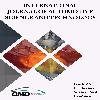A Study on the Effect of Injection Amount on NOx Emissions in the Selective Catalytic Reduction (SCR) System in a Single Cylinder Diesel Engine
diesel exhaust fluid (DEF); diesel engine; NOX emission; SCR, diesel exhaust fluid (DEF), diesel engine, NOX emission, SCR
A Study on the Effect of Injection Amount on NOx Emissions in the Selective Catalytic Reduction (SCR) System in a Single Cylinder Diesel Engine
diesel exhaust fluid (DEF), diesel engine, NOX emission, SCR,
___
- Brown KE, Henze DK, Milford JB. How accounting for climate and health impacts of emissions could change the US energy system. Energy Policy 2017;102:396–405. https://doi.org/10.1016/j.enpol.2016.12.052.
- Antoniotti M. Optimization of the AdBlue evaporation module for Scania V8 engines Optimization of the AdBlue evaporation unit for Scania V8 engines. KTH, Royal Institute of Technology, 2017.
- Braun P, Rabl HP, Matysik FM. Investigations on the Liquid-Phase Decomposition of AdBlue Urea for the Selective Catalytic Reduction Process. Chemie-Ingenieur-Technik 2019;91:961–8. https://doi.org/10.1002/cite.201800055.
- Jung SM, Demoulin O, Grange P. The study of a synergetic effect over a H-ZSM-5/V2O5 hybrid catalyst on SCR reaction. J Mol Catal A Chem 2005;236:94–8. https://doi.org/10.1016/j.molcata.2005.03.028.
- Kwon S, Park Y, Park J, Kim J, Choi KH, Cha JS. Characteristics of on-road NOx emissions from Euro 6 light-duty diesel vehicles using a portable emissions measurement system. Sci Total Environ 2017;576:70–7. https://doi.org/10.1016/j.scitotenv.2016.10.101.
- Sorrels JL, Randall DD, Schaffner KS, Fry CR. Chapter 2 Selective Catalytic Reduction. Econ Cost Anal Air Pollut Regul 2016. https://doi.org/10.1016/j.fertnstert.2015.01.016.
- Yadav I. AdBlue: An Overview. Int J Environ Sci 2011;2:756–64.
- Lázaro JL, García-Bernad JL, Pérez C, Galindo J, Climent H, Arnau FJ. Cooled EGR modulation: A strategy to meet EURO IV emission standards in automotive di diesel engines. 2002. https://doi.org/10.4271/2002-01-1154.
- Mazzoleni C, Moosmüller H, Kuhns HD, Keislar RE, Barber PW, Nikolic D, et al. Correlation between automotive CO, HC, NO, and PM emission factors from on-road remote sensing: implications for inspection and maintenance programs. Transp Res Part D Transp Environ 2004;9:477–96. https://doi.org/10.1016/J.TRD.2004.08.006.
- Kurzydym D, Zmudka Z, Perrone D, Klimanek A. Experimental and numerical investigation of nitrogen oxides reduction in diesel engine selective catalytic reduction system 2022;313. https://doi.org/10.1016/j.fuel.2021.122971.
- Kannepalli S. Mathematical Methods for Design of Zone Structured Catalysts and Optimization of Inlet Trajectories in Selective Catalytic Reduction (SCR) and Three Way Catalyst (TWC).
- Hountalas DT, Mavropoulos GC, Binder KB. Effect of exhaust gas recirculation (EGR) temperature for various EGR rates on heavy duty DI diesel engine performance and emissions. Energy 2008;33:272–83. https://doi.org/10.1016/J.ENERGY.2007.07.002.
- Uyumaz A, Boz F, Yılmaz E, Solmaz H, Polat S. Taşıt Egzoz Emisyonlarını Azaltma Yöntemlerindeki Gelişmeler. J Grad Sch Nat Appl Sci Mehmet Akif Ersoy Univ 2017:15–24.
- Braun P. Investigations on the reduction of engine-nitrogen-oxide emissions at low temperatures. 2019.
- Shin JH, Choi GR, Hong SC. Vanadium catalyst based on a tungsten trioxide structure modified with antimony in NH3-selective catalytic reduction for improved low-temperature activity. Appl Surf Sci 2022;574:151571. https://doi.org/10.1016/j.apsusc.2021.151571.
- Zhang Y, Yang S, Zhu X, Xu X, Huang F, Yang Z, et al. Effects of sulfation on hematite for selective catalytic reduction of nitrogen oxides with ammonia. J Colloid Interface Sci 2022;606:1445–56. https://doi.org/10.1016/j.jcis.2021.08.088.
- Koebel M, Elsener M, Kleemann M. Urea-SCR: a promising technique to reduce NOx emissions from automotive diesel engines. Catal Today 2000;59:335–45. https://doi.org/10.1016/S0920-5861(00)00299-6.
- Akihama K, Takatori Y, Inagaki K, Sasaki S, Dean AM. Mechanism of the Smokeless Rich Diesel Combustion by Reducing Temperature. SAE Tech Pap 2001. https://doi.org/10.4271/2001-01-0655.
- Alkaya B, Yıldırım AM. Taşit kaynakli ki̇rleti̇ci̇leri̇n azaltilma yöntemleri̇. Ekoloji 2000;34:15–20.
- Resitoglu IA, Keskin A. Hydrogen applications in selective catalytic reduction of NOx emissions from diesel engines. Int J Hydrogen Energy 2017;42:23389–94. https://doi.org/10.1016/j.ijhydene.2017.02.011.
- Weeks CL, Ibeling DR, Han S, Ludwig L, Ayyappan P. Analytical Investigation of Urea Deposits in SCR System. SAE Int J Engines 2015;8. https://doi.org/10.4271/2015-01-1037.
- Latha HS, Prakash KV, Veerangouda M, Maski D, Ramappa KT. A Review on SCR System for NOx Reduction in Diesel Engine. Int J Curr Microbiol Appl Sci 2019;8:1553–9. https://doi.org/10.20546/ijcmas.2019.804.180.
- Agarwal D, Singh SK, Agarwal AK. Effect of Exhaust Gas Recirculation (EGR) on performance, emissions, deposits and durability of a constant speed compression ignition engine. Appl Energy. 2011;88:2900–7. https://doi.org/10.1016/J.APENERGY.2011.01.066.
- Stelzer DM. Design and Evaluation of an Improved Mixer for a Selective Catalytic Reduction System by 2014.
- ANTOR 3LD510 Use and Maintenance Manual https://anadolumotor.com/_docs/uploads/pdf/ANTOR_3LD510_Kullanim_Bakim_El_Kitapcigi_TR_ENG_FR.pdf (accessed February 13, 2023).
- BEA 060-Bosch Emissions Analysis-Technical Data http://mediathek.bosch-automotive.com/files/bosch_wa/989/182.pdf (accessed February 13, 2023).
- Diesel Systems Denoxtronic 2.2 – Urea Dosing System for SCR systems (2014)- Technical Features https://www.yumpu.com/en/document/read/7945158/diesel-systems-denoxtronic-22-bosch-automotive-technology (accessed February 13, 2023).
- The dosing module is designed to inject AdBlue® into the exhaust system-Technical specifications. https://www.bosch-mobility-solutions.com/en/solutions/exhaust-gas-treatment/dosing-module-cv/ (accessed February 13, 2023).
- Kouremenos DA, Hountalas DT, Binder KB, Raab A, Schnabel MH. Using Advanced Injection Timing and EGR to Improve DI Diesel Engine Efficiency at Acceptable NO and Soot Levels. SAE International; 2001. https://doi.org/10.4271/2001-01-0199.
- Gall M. Study of SCR using Cu-Zeolite catalysts on a light-duty diesel engine under steady state and transient conditions Study of SCR using Cu-Zeolite catalysts on a light-duty diesel engine under steady state and transient. Coventry University, 2015.
- Yayın Aralığı: 4
- Başlangıç: 2016
- Yayıncı: Otomotiv Mühendisleri Derneği
Emrah ERÇEK, Şükrü Ayhan BAYDIR
Brazing of Different Metal Alloys with Highly-Silver Flux Addition and Microstructure Investigation
Mechanical Evaluation of Road Durability Test in Battery Electric Buses
Efe SAVRAN, Burcu YILDIRIM, Umut ÇANDIR, Fatih KARPAT
Performance Analysis of Geometric Properties of Fuel Cell Components
Beyza Nur YAVUZ, Hüseyin KAHRAMAN
Mustafa AKIN, Mehmet Can DURMUŞ, İmren MEYDAN, Emel ATILAL
Modeling of Electric Vehicles as a Load Of The Distribution Grid
Nurullah ASLAN, Erdal KILIC, Mustafa ŞEKKELİ
Case Study of Intralogistics in The Framework of Logistics 4.0
A Gear Form-Grinding Optimization Method Based on Neural Network
